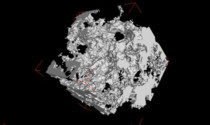Soil scientists at Abertay University are using 3D printing technology to try to discover exactly what is going on underneath our feet.
Professor Wilfred Otten and researchers at the university’s SIMBIOS Centre are taking advantage of the new technology to study the interactions of living organisms below ground.
Using x-ray Computed Tomography (CT scanning), the team have already created 3D images of the intricate structure of soil and found it to have a network of pores like the holes in emmental cheese.
They now want to know how these holes or “pore spaces” determine the ways in which fungi and bacteria living within them interact.
Using the printing technology, scientists can now turn the 3D images that they have managed to capture into real-life, hand-held 3D objects.
By inserting micro-organisms into the pore spaces within the plastic soil, the scientists can now observe how they move through it, survive, find food sources and interact.
Before CT scanning became available, soil samples were dug up and the structure and pore networks of the earth were inevitably disrupted before they could be studied by scientists.
Prof Otten said: “That’s like studying the rubble of a collapsed building you would never be able to tell what the structure of the building had been before it fell down, how many rooms it had, or how many people lived in or used it, and all the different things the different people used it for.
“These days we all know about the ways that species interact with each other and their environments above ground and how sensitive they are to changes in their habitats.
“What we often forget, however, is that everything above ground relies on the soil it stands on. It plays a major role in food security and the carbon cycle, for example but we still know very little about what goes on down there.”
Prof Otten said in recent years scientists have become aware that there are millions of microscopic organisms living in a single gramme of soil.
He said: “It has always been difficult to study these interactions in the natural environment so 3D printing is a major breakthrough for us, because we now have the ability to examine the structure up close.”
By having a better understanding of what exactly goes on underground, he said, we will eventually be able to better understand the implications the over-use of soil has for food security and soil’s role in climate change.
Dr Ruth Falconer added: “We can analyse one species to begin with providing it with simple food sources and gradually add more complexity, so that we can eventually get close to replicating the environment they would naturally live in below ground.”
